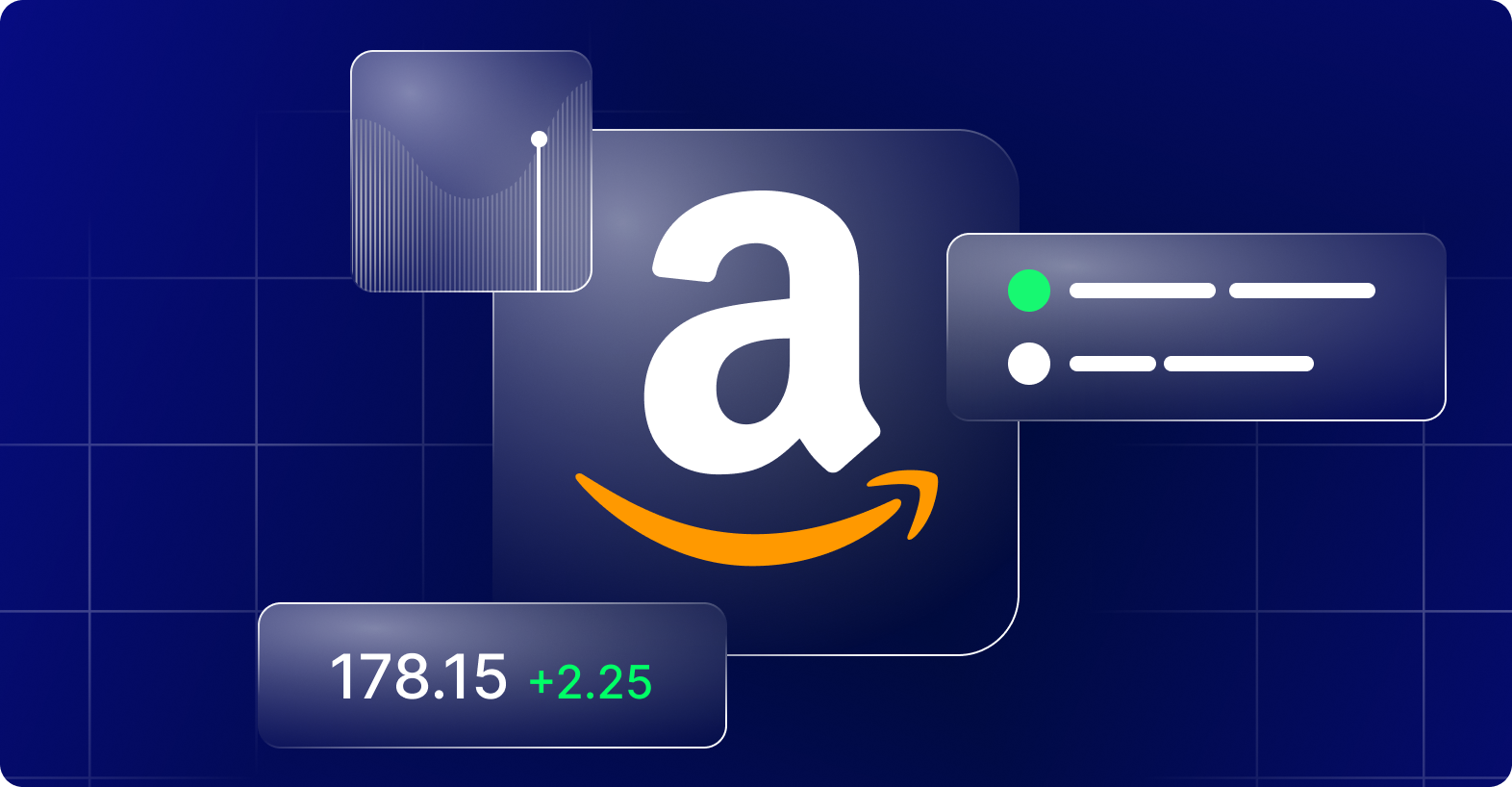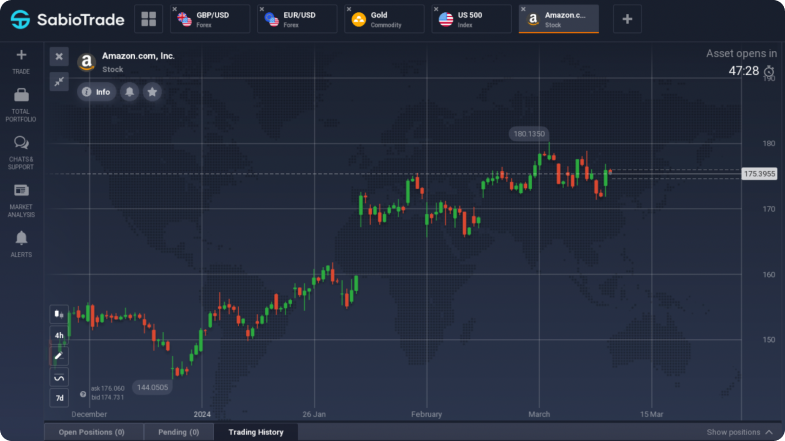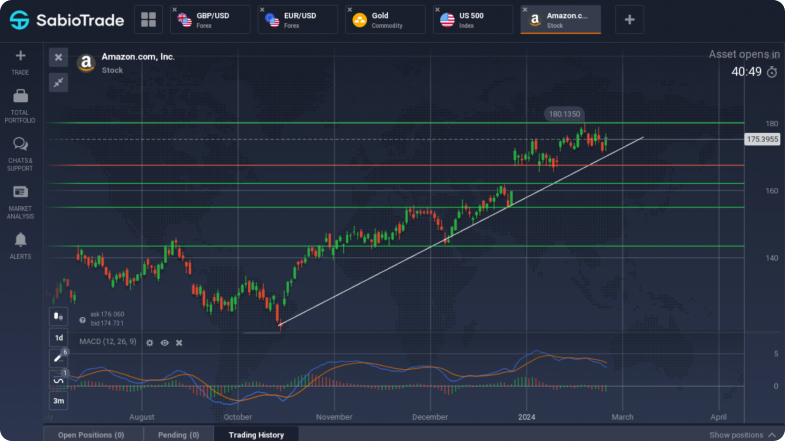Amazon Stocks Insight: Analysis and Forecast


In the pivotal year of 1997, Amazon evolved from an emerging online bookstore into a publicly traded behemoth, launching its IPO on NASDAQ under the ticker NASDAQ: AMZN, with shares initially offered at $18. Progressing to September 4, 2018, Amazon marked its position as the second company in history to reach the monumental milestone of a $1 trillion market capitalization, reinforcing its dominance in the e-commerce realm with unparalleled zeal. Currently, Amazon extends beyond merely leading the e-commerce sector; it almost monopolizes it, leaving its competitors in a challenging position to narrow the gap or question its superiority.
This ascent of Amazon highlights the potential embedded in trading its shares, particularly through Contracts for Difference (CFDs), presenting an alternative avenue to conventional stock trading. Unlike the direct acquisition of live shares, which results in shareholding and equity within the company, CFD trading on Amazon.com facilitates investors to speculate on the share price movements without actual ownership.
It distinguishes itself by offering financial leverage and the capability to gain from both market ascents and descents. Through CFDs, investors can opt to sell short, anticipating a decline in Amazon’s share price, or buy long, foreseeing an increase, thereby enabling profit opportunities across diverse market scenarios. This bifurcated approach, incorporating both an introduction to Amazon’s market influence and a deep dive into the mechanics and advantages of CFD trading compared to traditional stock investments, aims to provide a thorough understanding for potential traders and investors.
Before delving into the nuances of investing in Amazon, it’s essential to highlight two critical areas where Amazon could stand to improve:
Amazon’s Financial Stability: The company’s business model exhibits certain vulnerabilities that could potentially impact its operational profit margins, raising concerns among shareholders about the future financial trajectory of Amazon.
Market Share in Online Retail: Amazon’s dominant position in online retail has been a point of contention, inviting scrutiny and raising the risk of new antitrust regulations. Before a deep dive into the strategic acquisition of Amazon shares, prospective investors can gain firsthand experience of the stock’s price fluctuations and refine their trading and investment strategies by utilizing a free demo account, allowing for practice with virtual funds.

Amazon, 4H Graph
Deciding whether to invest in Amazon or any other entity necessitates a thorough review of the company’s financial track record.
For about the last ten years, Amazon has successfully maintained a strong revenue stream. Let’s delve into the company’s financial results for the second quarter of 2023.
| Q2 2023 | Q2 2022 | |
| Revenue | $134.4 billion | $121.2 billion |
| Operating Income | $7.7 billion | $3.3 billion |
| Net Profit | $6.7 billion | -$2 billion |
The company’s revenue and earnings per share exceeded expectations, leading to an increase in Amazon’s stock price.
Since 2021, Amazon shares have been trading within a bearish channel. However, as we can see from the chart, starting from 2023, the price has begun to recover:

Amazon, Daily Graph
We’ve added support and resistance levels (red and green) to the chart, which will help identify potential price movements. These levels should be considered before purchasing Amazon stocks.
The recent drop in Amazon stock prices presented an opportunity for those trading Amazon CFDs, rather than buying the stocks outright.
Given that Amazon’s stocks don’t always follow an upward trend, you might want to consider trading Contracts for Difference (CFDs) on Amazon stocks! CFDs allow traders to attempt to profit from both rising and falling prices.
Until not too long ago, Amazon’s share prices were notably high, priced around $3000 USD, posing a significant barrier for potential investors. To make its shares more accessible and appealing, Amazon decided on a 20:1 stock split. This strategic move resulted in:
Amazon’s operations can be categorized into two pivotal sectors: the expansive realm of e-commerce and the technological powerhouse, Amazon Web Services (AWS). The company is renowned for its unparalleled customer service, offering numerous benefits through the Amazon Prime subscription that ensures swift two-day delivery, making it a favorite among users. Notably, Prime members tend to engage in more frequent purchases on Amazon.com, highlighting the platform’s capacity to retain customers through its premium service.
The synergy between AWS’s cutting-edge cloud computing solutions and Amazon’s retail prowess provides a compelling narrative for those looking to dive into the dynamics of CFD trading on Amazon stocks. This fusion not only enhances the shopping experience, encouraging consumers to return but also positions Amazon as a lucrative option for investors seeking long-term growth opportunities.
Despite the meteoric rise in Amazon’s share prices benefiting shareholders, it has posed barriers for potential investors due to the steep cost. Nevertheless, the recent downtrend since late 2021, influenced by the broader tech sector’s decline and Amazon’s performance, coupled with a strategic stock split making shares more accessible, signals a prime opportunity for CFD traders. This guide to contracts for difference on Amazon shares, incorporating essential insights from Jeff, offers a strategic overview for those looking to navigate the complexities of the financial markets.
Investors and traders are advised to consider this guide as a crucial resource for understanding the fluctuations in Amazon’s stock prices, providing a comprehensive strategy for leveraging Amazon’s current market position. However, it’s vital to approach CFD trading with an informed perspective, acknowledging the inherent risks in market operations and the importance of effective risk management techniques.
By embracing the complexities of trading Amazon, whether through direct stock purchases or CFDs, investors can navigate the financial markets more effectively. With the right strategy, information, and tools, trading Amazon offers a pathway to potential financial success and independence.